Tenby: Difference between revisions
Created page with '{{Infobox town |name=Tenby |welsh=Dinbych-y-Pysgod |county=Pembrokeshire |picture=Tenby - Wales - Harbour.jpg |picture caption=Tenby Harbour and old town |os grid ref=SN136004 |…' |
No edit summary |
||
| (2 intermediate revisions by 2 users not shown) | |||
| Line 16: | Line 16: | ||
|constituency=Carmarthen West and South Pembrokeshire | |constituency=Carmarthen West and South Pembrokeshire | ||
}} | }} | ||
'''Tenby''' is a walled seaside town in [[Pembrokeshire]]. It stands on [[Carmarthen Bay]]. It has 2½ miles of sandy beaches to tempt holiday-makers and history built into its stones. The Pembrokeshire Coast Path, part of Britain’s only coastal National Park, passes through the town. Boats sail from Tenby's harbour to the offshore monastic [[Caldey Island]], while [[St Catherine's Island]] is linked to the town at low tide. The town is served by Tenby railway station. | '''Tenby''' is a walled seaside town and parish in [[Pembrokeshire]]. It stands on [[Carmarthen Bay]]. It has 2½ miles of sandy beaches to tempt holiday-makers and history built into its stones. The [[Pembrokeshire Coast Path]], part of Britain’s only coastal National Park, passes through the town. Boats sail from Tenby's harbour to the offshore monastic [[Caldey Island]], while [[St Catherine's Island]] is linked to the town at low tide. The town is served by Tenby railway station. | ||
The | The town's name derives from the Welsh language, in which the town is known as ''Dinbych-y-Pysgod'', meaning ''little town of the fishes'' or ''little fortress of the fish''. | ||
The ancient parish is divided into St Mary In Liberty, namely that part inside the town itself, and [[St Mary Out Liberty]]. | |||
==The town== | ==The town== | ||
[[File:tenby2567lg.JPG|thumb|right|200px|Colour and variety of the shops of Tenby]] | [[File:tenby2567lg.JPG|thumb|right|200px|Colour and variety of the shops of Tenby]] | ||
Tenby has 13th century mediæval town walls, including the Five Arches barbican gatehouse. | Tenby has 13th-century mediæval town walls, including the Five Arches barbican gatehouse. | ||
Within the town are a 15th century parish church, St Mary's, a Tudor Merchant's House (now owned by the [[National Trust for Places of Historic Interest or Natural Beauty|National Trust]]) and a museum with art gallery. | Within the town are a 15th-century parish church, St Mary's, a Tudor Merchant's House (now owned by the [[National Trust for Places of Historic Interest or Natural Beauty|National Trust]]) and a museum with art gallery. | ||
Modern Tenby provides many items and activities for both the local resident and out of season tourists to enjoy. | Modern Tenby provides many items and activities for both the local resident and out of season tourists to enjoy. | ||
| Line 52: | Line 54: | ||
Resultantly bereft of trade, the town was abandoned by the merchants, and slid inexorably into decay and ruin. By the end of the eighteenth century, the visiting John Wesley noted how: ''"Two-thirds of the old town is in ruins or has entirely vanished. Pigs roam among the abandoned houses and Tenby presents a dismal spectacle."''<ref name=Kuiters>{{cite web|url=http://kuiters.org/wgj/history/botgardpaxton.html|title=Sir William Paxton|publisher=kuiters.org|accessdate=16 September 2011}}</ref> | Resultantly bereft of trade, the town was abandoned by the merchants, and slid inexorably into decay and ruin. By the end of the eighteenth century, the visiting John Wesley noted how: ''"Two-thirds of the old town is in ruins or has entirely vanished. Pigs roam among the abandoned houses and Tenby presents a dismal spectacle."''<ref name=Kuiters>{{cite web|url=http://kuiters.org/wgj/history/botgardpaxton.html|title=Sir William Paxton|publisher=kuiters.org|accessdate=16 September 2011}}</ref> | ||
===Ninteenth century revival=== | ===Ninteenth-century revival=== | ||
[[File:tenby2550lg.JPG|thumb|left|200px|View upwards to the promenade]] | [[File:tenby2550lg.JPG|thumb|left|200px|View upwards to the promenade]] | ||
The Napoleonic Wars restricting rich tourists from accessing the spa resorts in Europe, and so the need for home-based sea bathing grew. In 1802, locally resident merchant banker and politician Sir William Paxton bought his first property in the old town. From this point | The Napoleonic Wars restricting rich tourists from accessing the spa resorts in Europe, and so the need for home-based sea bathing grew. In 1802, locally resident merchant banker and politician Sir William Paxton bought his first property in the old town. From this point onwards he invested heavily in the town, with the full approval of the town council. Engaging the team who had built his home at Middleton Hall, engineer James Grier and architect Samuel Pepys Cockerell were briefed to create a ''"bathing establishment suitable for the highest society."'' | ||
Paxton's baths came into operation in July 1806, and after acquiring the Globe Inn transformed it into ''"a most lofty, elegant and convenient style"'' to lodge the more elegant visitors to his baths. Cottages were erected adjoining the baths, and livery stables with an adjoining coach house. In 1814 a road built on arches overlooking the harbour was built at Paxton's full expense. However, although he later got passed a Bill in Parliament to enable fresh water to be piped through the town, his 1809 theatre was closed in 1818 due to lack of patronage.<ref name=Kuiters/> | Paxton's baths came into operation in July 1806, and after acquiring the Globe Inn transformed it into ''"a most lofty, elegant and convenient style"'' to lodge the more elegant visitors to his baths. Cottages were erected adjoining the baths, and livery stables with an adjoining coach house. In 1814 a road built on arches overlooking the harbour was built at Paxton's full expense. However, although he later got passed a Bill in Parliament to enable fresh water to be piped through the town, his 1809 theatre was closed in 1818 due to lack of patronage.<ref name=Kuiters/> | ||
[[File:tenby2554lg.JPG|thumb|right|200px|St Catherine's Island]] | [[File:tenby2554lg.JPG|thumb|right|200px|St Catherine's Island]] | ||
Paxton also took in "tour" developments in the area, as required by rich Victorian tourists. This included the discovery of a chalybeate spring in his own park at Middleton Hall, and coaching inns from Swansea to [[Narbeth]]. He also built Paxton's Tower, in memorial to Lord Nelson whom he had met in 1802 when Mayor of Carmarthen.<ref name=Kuiters/> Paxton's efforts to revive the town | Paxton also took in "tour" developments in the area, as required by rich Victorian tourists. This included the discovery of a chalybeate spring in his own park at Middleton Hall, and coaching inns from Swansea to [[Narbeth]]. He also built Paxton's Tower, in memorial to Lord Nelson whom he had met in 1802 when Mayor of Carmarthen.<ref name=Kuiters/> Paxton's efforts to revive the town succeeded, and even when victory at the Battle of Trafalgar reopened Europe, the growth of Tenby was inevitable. Through both the Georgian and Victorian eras Tenby was renowned as a health resort and centre for botanical and geological study.<ref>http://www.virtualtenby.co.uk/hist-vict.asp</ref> | ||
Many features of the town were built to provide areas for healthy seaside walks, the walkways built to accommodate those pushing perambulators, and as such serve as good disabled access today. In 1856 the authoress George Eliot accompanied George Henry Lewes to Tenby to gather materials for his work ''Seaside Studies'' published in 1858. | Many features of the town were built to provide areas for healthy seaside walks, the walkways built to accommodate those pushing perambulators, and as such serve as good disabled access today. In 1856 the authoress George Eliot accompanied George Henry Lewes to Tenby to gather materials for his work ''Seaside Studies'' published in 1858. | ||
| Line 68: | Line 70: | ||
Tenby railway station was opened by the Pembroke and Tenby Railway as the terminus of the branch from the Pembroke direction in 1863,<ref>[http://www.pembrokeshirevirtualmuseum.co.uk/main_menu/trade_and_industry/trains/a_chronology_of_pembrokeshire_railways.html History of Pembrokeshire Railways] Pembrokeshire Virtual Museum; Retrieved 2009-03-03</ref> with the section eastwards to join the main line at Whitland railway station|Whitland following three years later. The Palmerstone Forts|Palmerstone Fort on St Catherine's Island was begun in 1867 and completed in 1880.<ref>http://stcatherinesisland.fotopic.net/</ref> | Tenby railway station was opened by the Pembroke and Tenby Railway as the terminus of the branch from the Pembroke direction in 1863,<ref>[http://www.pembrokeshirevirtualmuseum.co.uk/main_menu/trade_and_industry/trains/a_chronology_of_pembrokeshire_railways.html History of Pembrokeshire Railways] Pembrokeshire Virtual Museum; Retrieved 2009-03-03</ref> with the section eastwards to join the main line at Whitland railway station|Whitland following three years later. The Palmerstone Forts|Palmerstone Fort on St Catherine's Island was begun in 1867 and completed in 1880.<ref>http://stcatherinesisland.fotopic.net/</ref> | ||
{{clear}} | {{clear}} | ||
==Tourism== | ==Tourism== | ||
[[File:tenby2546lg.JPG|thumb|right|250px|The long sandy beaches of Tenby]] | [[File:tenby2546lg.JPG|thumb|right|250px|The long sandy beaches of Tenby]] | ||
Due to its coastal, | Due to its coastal, south-westerly position, Tenby is one of the sunnier locations in Wales. | ||
Tenby is an exceptionally busy British holiday resort in the summer. The relatively unspoilt beaches and historic town walls make it a notable seaside resort. Most shops, pubs and restaurants in Tenby are specifically marketed to tourists. | Tenby is an exceptionally busy British holiday resort in the summer. The relatively unspoilt beaches and historic town walls make it a notable seaside resort. Most shops, pubs and restaurants in Tenby are specifically marketed to tourists. | ||
| Line 79: | Line 80: | ||
*Tenby United RFC (rugby union) has existed in the town in one form or another since 1876 and is a member of the Welsh Rugby Union. | *Tenby United RFC (rugby union) has existed in the town in one form or another since 1876 and is a member of the Welsh Rugby Union. | ||
*Tenby Aces Cycling Club have expanded quickly to become the largest club in southern Pembrokeshire. | *Tenby Aces Cycling Club have expanded quickly to become the largest club in southern Pembrokeshire. | ||
*Tenby golf course provides a challenging 18 hole links golf challenge. | *Tenby golf course provides a challenging 18-hole links golf challenge. | ||
==Outside links== | ==Outside links== | ||
| Line 89: | Line 87: | ||
*[http://www.tenbymalechoir.org Tenby Male Choir] | *[http://www.tenbymalechoir.org Tenby Male Choir] | ||
*[http://www.virtualtenby.co.uk/webcamlive.asp Live webcam of Tenby Harbour] | *[http://www.virtualtenby.co.uk/webcamlive.asp Live webcam of Tenby Harbour] | ||
==References== | |||
{{reflist}} | |||
[[Category:Seaside resorts in Pembrokeshire]] | |||
Latest revision as of 13:08, 7 December 2016
| Tenby Welsh: Dinbych-y-Pysgod | |
| Pembrokeshire | |
|---|---|
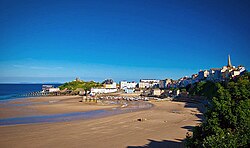 Tenby Harbour and old town | |
| Location | |
| Grid reference: | SN136004 |
| Location: | 51°40’28"N, 4°42’16"W |
| Data | |
| Population: | 4,933 (2001) |
| Post town: | Tenby |
| Postcode: | SA70 |
| Dialling code: | 01834 |
| Local Government | |
| Council: | Pembrokeshire |
| Parliamentary constituency: |
Carmarthen West and South Pembrokeshire |
Tenby is a walled seaside town and parish in Pembrokeshire. It stands on Carmarthen Bay. It has 2½ miles of sandy beaches to tempt holiday-makers and history built into its stones. The Pembrokeshire Coast Path, part of Britain’s only coastal National Park, passes through the town. Boats sail from Tenby's harbour to the offshore monastic Caldey Island, while St Catherine's Island is linked to the town at low tide. The town is served by Tenby railway station.
The town's name derives from the Welsh language, in which the town is known as Dinbych-y-Pysgod, meaning little town of the fishes or little fortress of the fish.
The ancient parish is divided into St Mary In Liberty, namely that part inside the town itself, and St Mary Out Liberty.
The town
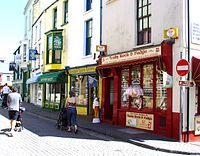
Tenby has 13th-century mediæval town walls, including the Five Arches barbican gatehouse.
Within the town are a 15th-century parish church, St Mary's, a Tudor Merchant's House (now owned by the National Trust) and a museum with art gallery.
Modern Tenby provides many items and activities for both the local resident and out of season tourists to enjoy.
The old town castle walls still survive, as does the Victorian revival architecture which has been retained and maintained, often in a high-light orientated pastel colour scheme, making the town more French Riviera-esque in nature and feel.
The economy is still highly based around tourism, supported by the provision of a range of craft, art and local goods stores, which has been created by a thriving artist community.
History

With its strategic position on the far west coast of the British Isles, and a natural sheltered harbour from both the Atlantic Ocean and the Irish Sea, Tenby was a natural settlement point.
The earliest reference to a settlement at Tenby is in Etmic Dinbych, a poem probably of the 9th century, preserved in the 14th century Book of Taliesin. At this point the settlement was likely a hill fort, the mercantile nature of the settlement possibly developing under Hiberno-Norse influence.
After the Norman Conquest, the lands came under the control of the Earls of Pembroke, who strengthened the hill fort on Castle Hill by building the first stone walled castle. This enabled the town to grow as a seaport. But the need for additional defences was shown, when attacked by the Welsh princes in 1187 and again in 1260 by Llewelyn the Great.[1] The town walls were built by William de Valence, 1st Earl of Pembroke, in the late 13th century.
Mediæval walled town, trading port
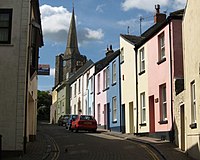
The Earl's decision spurred the town's landowners to develop extensive walls, enclosing a large part of the town into what is now termed the "old town." Although the original wooden gates into Tenby no longer exist, the Five Arches at the edge of old town give an insight into what the merchants would have marvelled at as they entered.[2]
During the Wars of the Roses, Henry Earl of Richmond, the future King Henry VII sheltered within Tenby before sailing into exile in 1471. In late mediæval times through the 14th and 15th centuries, Tenby was awarded various royal grants which financed the maintenance and improvement of the town walls and the enclosure of Tenby Harbour. The harbour during this period became a busy and important national port. Originally based on fish trading, traders sailing along the coast to Bristol and Ireland, and further afield to France, Spain and Portugal. Exports from Tenby included wool, skins, canvas, coal, iron and oil; while in 1566 Portuguese seamen landed the first oranges to be brought to Wales.[2]
Decline
Two events caused the town to decline in importance, quickly and permanently. Firstly, in the English Civil War, the town declared for Parliament, and resisted two attempts by Charles Gerard, 1st Earl of Macclesfield, to capture it for the King. In 1648, the Royalists captured the castle for ten weeks before surrendering to Colonel Thomas Horton,[1] who welcomed Oliver Cromwell to the town shortly afterwards.[2] In the following year, 1650, a plague epidemic killed half its population.
Resultantly bereft of trade, the town was abandoned by the merchants, and slid inexorably into decay and ruin. By the end of the eighteenth century, the visiting John Wesley noted how: "Two-thirds of the old town is in ruins or has entirely vanished. Pigs roam among the abandoned houses and Tenby presents a dismal spectacle."[3]
Ninteenth-century revival
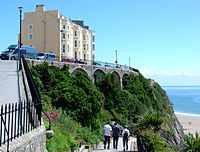
The Napoleonic Wars restricting rich tourists from accessing the spa resorts in Europe, and so the need for home-based sea bathing grew. In 1802, locally resident merchant banker and politician Sir William Paxton bought his first property in the old town. From this point onwards he invested heavily in the town, with the full approval of the town council. Engaging the team who had built his home at Middleton Hall, engineer James Grier and architect Samuel Pepys Cockerell were briefed to create a "bathing establishment suitable for the highest society."
Paxton's baths came into operation in July 1806, and after acquiring the Globe Inn transformed it into "a most lofty, elegant and convenient style" to lodge the more elegant visitors to his baths. Cottages were erected adjoining the baths, and livery stables with an adjoining coach house. In 1814 a road built on arches overlooking the harbour was built at Paxton's full expense. However, although he later got passed a Bill in Parliament to enable fresh water to be piped through the town, his 1809 theatre was closed in 1818 due to lack of patronage.[3]
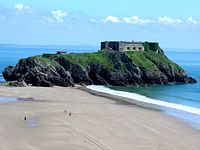
Paxton also took in "tour" developments in the area, as required by rich Victorian tourists. This included the discovery of a chalybeate spring in his own park at Middleton Hall, and coaching inns from Swansea to Narbeth. He also built Paxton's Tower, in memorial to Lord Nelson whom he had met in 1802 when Mayor of Carmarthen.[3] Paxton's efforts to revive the town succeeded, and even when victory at the Battle of Trafalgar reopened Europe, the growth of Tenby was inevitable. Through both the Georgian and Victorian eras Tenby was renowned as a health resort and centre for botanical and geological study.[4]
Many features of the town were built to provide areas for healthy seaside walks, the walkways built to accommodate those pushing perambulators, and as such serve as good disabled access today. In 1856 the authoress George Eliot accompanied George Henry Lewes to Tenby to gather materials for his work Seaside Studies published in 1858.
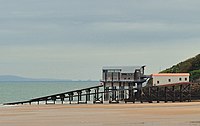
In 1852, The Shipwrecked Fishermen and Mariners' Royal Benevolent Society deployed a lifeboat to the town, taken over in 1854 by the Royal National Lifeboat Institution. This led in 1905 to the building of the first slip-way equipped Lifeboat Station, which was replaced in 2008.
Tenby railway station was opened by the Pembroke and Tenby Railway as the terminus of the branch from the Pembroke direction in 1863,[5] with the section eastwards to join the main line at Whitland railway station|Whitland following three years later. The Palmerstone Forts|Palmerstone Fort on St Catherine's Island was begun in 1867 and completed in 1880.[6]
Tourism
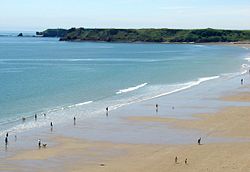
Due to its coastal, south-westerly position, Tenby is one of the sunnier locations in Wales.
Tenby is an exceptionally busy British holiday resort in the summer. The relatively unspoilt beaches and historic town walls make it a notable seaside resort. Most shops, pubs and restaurants in Tenby are specifically marketed to tourists.
Sport
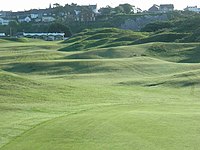
- Tenby United RFC (rugby union) has existed in the town in one form or another since 1876 and is a member of the Welsh Rugby Union.
- Tenby Aces Cycling Club have expanded quickly to become the largest club in southern Pembrokeshire.
- Tenby golf course provides a challenging 18-hole links golf challenge.
Outside links
References
- ↑ 1.0 1.1 http://www.castlewales.com/tenby.html
- ↑ 2.0 2.1 2.2 "tenby". penmar-tenby.co.uk. http://www.penmar-tenby.co.uk/tenby.html. Retrieved 16 September 2011.
- ↑ 3.0 3.1 3.2 "Sir William Paxton". kuiters.org. http://kuiters.org/wgj/history/botgardpaxton.html. Retrieved 16 September 2011.
- ↑ http://www.virtualtenby.co.uk/hist-vict.asp
- ↑ History of Pembrokeshire Railways Pembrokeshire Virtual Museum; Retrieved 2009-03-03
- ↑ http://stcatherinesisland.fotopic.net/